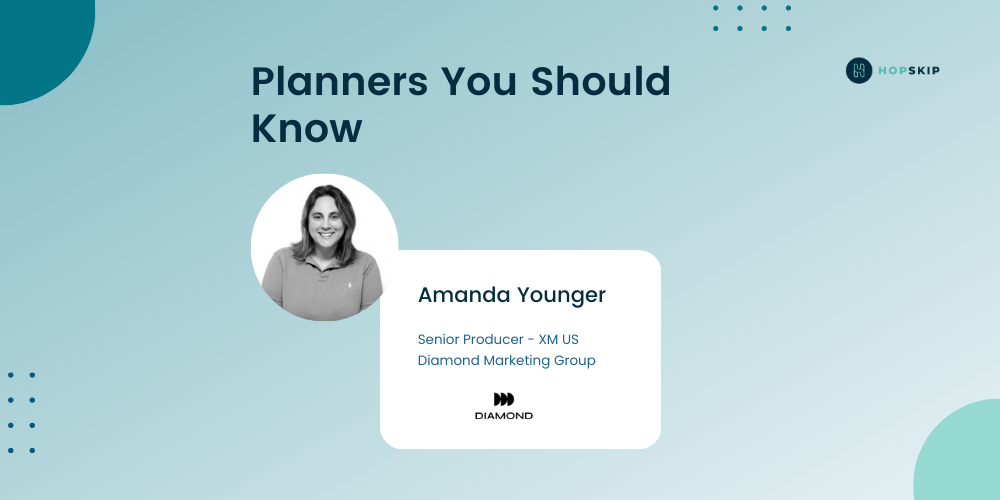Planners You Should Know - Amanda Younger, Diamond Marketing Group
Amanda Younger, of Diamond Marketing Group, discusses how she honed her skills over the pandemic to now be in position to overcome the challenges that the new meetings/events landscape brings.
Luke Whalin
Feb 17, 2023

This post is part of the HopSkip Planner Spotlight Series where HopSkip spotlights planners across the industry to bring awareness of how they adapted to COVID-19, communicating and lessons learned and sharing how they are viewing the meetings and events industry in a post-pandemic world.
Name: Amanda Younger
Company Name: Diamond Marketing Group
Job Title: Senior Producer - XM US
Years of Experience: 15
How did you get your start in the events industry? What made you pursue this role?
After grad school, I began Spring Break promotions in Florida, which led to touring, which led to operations which led to management which led to production.
How do you compare planning your first in-person event post-pandemic, to planning meetings/events pre- Covid? What was different and unique? What was similar?
What was your number one challenge in hosting your first in-person event(s) and how did you overcome it?
The greatest difference in planning live events from a pre-to-post-pandemic world is risk measurement. If another variant emerges, what is the loss in cancellation or moved date? Do we have a hybrid or digital experience integrated that we can lean on more in the case of a new variant? If the live event stays on, do we have enough safety precautions in place for staff and attendees? Once you measure risk, you still have to perform an elevated experience of connection for attendees to engage with the event and participate together.
Managing my first live event in my career, I was worried about how many people would attend. With experience, you learn more promotional estimations to get a more accurate guest count before the event launch. From a usual crowd of 7,000 in previous years, hosting the same event post-pandemic was significantly smaller in capacity with pod seating. The video stopped playing an hour into the event, and we moved to a live DJ on site while replaying the day's videos to online viewers. Although it was not ideal, onsite attendees enjoyed their experience, and those that tuned in saw earlier broadcasts they had missed from the day. Internally, we felt a live and recorded feed should be available in the event video, or tech issues arise for our hybrid audience.
What is the top learning that you uncovered from the last two years that you’re implementing in your planning process today? (any other tips or tricks you want to share?)
Always equip your staff and the event with hand sanitizing stations. Always have a live posting of photos and videos throughout the day for those missing the in-person experience. Always have multiple and diverse ways to reach your digital audience. Never forget the importance of connection for your live event experience.
Our industry is about people, and your network is crucial in finding solutions. Many industries have lost many people in the pandemic, especially those in the service industries with the public. Setting expectations with clients is a priority from the beginning based on new surplus-chain issues, inflation costs, and vendor delays. Find your hospitality partners, and give them FYIs whenever new briefs and event proposals are brought in. This way, your vendors can prepare once you get client approvals in line.
We are selecting hotel partners on an event-by-event basis and keeping our hospitality selections flexible and diverse.
If there is short-staffing in the conference areas of the hotel, we need the approval of third-party vendors earlier in the process to supplement the event.
Due to the pandemic, our events community had to evolve, adapt, and grow. Many planners started to embrace new technologies as a result of the pandemic. What new tech are you using today in your planning process as a result?
This post is part of the HopSkip Planner Spotlight Series where HopSkip spotlights planners across the industry to bring awareness of how they adapted to COVID-19, communicating and lessons learned and sharing how they are viewing the meetings and events industry in a post-pandemic w,orld.
Contactless donation/Tip jars for charity/Non-profits, self-service tablet stations, RFID tracking, and digital demos with chats and pop up Advertisements for Sponsors.
Since education and relationships are two major pillars in the meetings and events industry, any suggestions on how other planners can learn and network with their peers across the industry?
Linked In is the go-to networking app for professionals, although I find it is important to add yourself to industry groups across many social platforms to ask for help or advice from others.